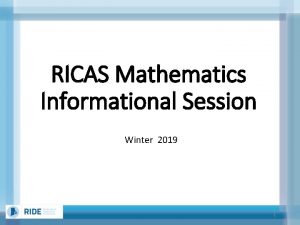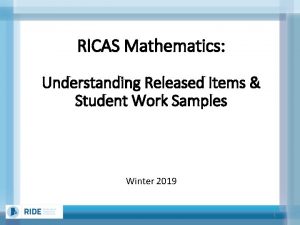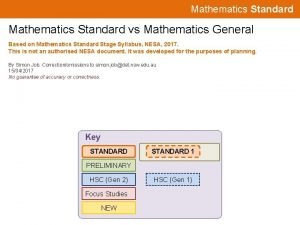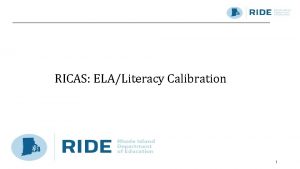RICAS Creating Data Looks for RICAS Mathematics Winter









































- Slides: 41

RICAS: Creating Data Looks for RICAS Mathematics Winter 2019

Steps to Organizing Data 1. 2. 3. 4. Download the data file Transfer Local District and School Data Create a Pivot Table Create a Data Display

1. Download the data file This presentation will deal primarily with the Item and Subscore reports available at: http: //www. ride. ri. gov/Instruction. Ass essment/Assessment/RICASReleased. I tems. aspx This demonstration will use grade 4 mathematics data reports.

2. Transfer Local District and School Data

2. Transfer Local District and School Data To compare district and school data to state data and the total possible points available, you will first need to move your district and school data to Tab 1 Move all district and School data here. Tab 2 Copy district data from here. Tab 3 Copy school data from here.

2. Transfer Local District and School Data Locate and copy your district data from Tab 2. (For the purpose of this demonstration, we will use Ancor, an imaginary district. ) Locate the district

2. Transfer Local District and School Data Copy the entire row of items, including the category summaries located at the far end of the row. Copy the entire row of data including the content summaries at the end.

2. Transfer Local District and School Data Return to Tab 1 and type “District Grade 4” in cell J 1 (next to “State Grade 4”). You will paste district data here.

2. Transfer Local District and School Data In the cell directly below “District Grade 4”, under the "Paste Special” category, use "Transpose" to allow the data to paste vertically in the column. Use the 4 th option, “Transpose” to paste the data down.

2. Transfer Local District and School Data When pasting the data, ensure the district and state cells align. If all columns are not in perfect alignment, undo and redo the "transpose". All data should stop here

2. Transfer Local District and School Data As you did for the district data, copy the school data located in Tab 3. (For the purpose of this demonstration, we will use the school, Euclid Elementary. ) Locate the School

2. Transfer Local District and School Data Copy the entre row of items. Remember to include the category summaries at the end of the row. Copy the entire row of data including the content summaries at the end.

2. Transfer Local District and School Data Return to Tab 1 and type “School Name” in cell K 1 (to the right of “District Grade 4”). Type the school name here.

2. Transfer Local District and School Data In the cell directly below “School Name”, under the "Paste Special” category, use "Transpose" to allow the data to paste vertically in the column. Use the 4 th option, “Transpose” to paste the data down.

2. Transfer Local District and School Data When pasting the data, ensure the district and state cells align. If all columns are not in perfect alignment, undo and redo the "transpose". All data should stop here.

3. Create a Pivot Table for Reporting Categories

3. Create a Pivot Table for Reporting Categories In Excel, a Pivot table is the best way to aggregate data in order to create data displays. To begin a Pivot table, copy all the data from Tab 1, including the two new columns for district and school data.

3. Create a Pivot Table for Reporting Categories Copy all data from Tab 1(State). All data in the sheet will be copied if this cell is clicked and copied (located above 1 and to the left of A).

3. Create a Pivot Table for Reporting Categories Once all the data is copied, select "Insert" and then click on the “Pivot Table” icon. The insert tab contains the Pivot Table icon.

3. Create a Pivot Table for Reporting Categories Once the "Pivot Table" icon is clicked, Excel will present several options for you to select concerning the data. "New Worksheet" will create a new tab that will house your Pivot Table. Use this option. Make sure the range matches your data set.

3. Creating a Pivot Table for Reporting Categories Your new tab will be blank with Pivot Table properties. The new tab in Sheets, located here, should be renamed by the user. These fields control the creation of the graph.

3. Create a Pivot Table for Reporting Categories Once you have a blank Pivot Table check off Reporting Category. Reporting categories are displayed here. Check the “Reporting Category” box. Reporting Category will show here in rows.

3. Create a Pivot Table for Reporting Categories Next check off fields in this order: 1. Possible points 2. State Grade 04 3. District Grade 04 – this was carried over from MAT 04 District 4. Euclid ELM - – this was carried over from MAT 04 School These 4 should be checked.

3. Create a Pivot Table for Reporting Categories The next steps in creating the Pivot Table: 1. move the checked fields from ROWS to VALUES, and 2. change calculations from counts to sums. Move the bottom 4 fields The Values should look like this.

3. Create a Pivot Table for Reporting Categories Fourth step in creating the Pivot Table • Change the checked fields from Counts to Sums. This can be done by clicking the arrow in the field box. In this new box are options, the “Value Field Settings” will be needed to change values to Sums.

3. Create a Pivot Table for Reporting Categories Fourth step in creating a Pivot Table • Change the checked fields from Counts to Sums. In the “Value Field Settings” There will be different options for Summarizing the data, the Sum will be needed in order to have the values in the table add up. Highlight Sum and click OK.

3. Create a Pivot Table for Reporting Categories Fourth step in creating a Pivot Table • Change the other checked fields from Counts to Sums. This category is now a Sum, step 4 will need to be repeated for the other categories.

3. Create a Pivot Table for Reporting Categories Fourth step in creating a Pivot Table • Change the other checked fields from Counts to Sums. Once done these should all read “Sum” and the table is ready to create a graph.

4. Create a Data Display for Reporting Categories

4. Create a Data Display for Reporting Categories First step for a Data Display • Copy the pivot table chart. Don’t worry about the “blank” row, it will be filtered out in the next few steps.

4. Create a Data Display for Reporting Categories First step for a Data Display • Once the table in copied click the “Recommended Chart” icon under the Insert tab is where to find the Recommended Charts icon

4. Create a Data Display for Reporting Categories First step for a Data Display • There should be a Charts option box, the Clustered Column will be used for this display Make sure this is displayed and click “OK”.

4. Create a Data Display for Reporting Categories Second Step for a Data Display • Filter out the “blank” category Click here and uncheck the “blank box”.

4. Create a Data Display for Reporting Categories Second Step for a Data Display • Filter out the “blank” category Uncheck the “blank box” and Click “OK”.

4. Create a Data Display for Reporting Categories Once the “blank” category is removed then the data display is ready and can be enlarged and copied. 18 17 16 14 12 11 10 10 5, 54 5 6, 48 6, 81 4, 4 4 2 11 Sum of Possible Points 8, 26 8 6 9, 76 10, 38 1, 76 2, 35 5, 43 5, 08 6, 08 5, 96 5, 58 1, 9 0 Geometry Measurement & Data Number & Operations in Base Operations-Fractions Algebraic Thinking Ten Sum of State Grade 04 Sum of District Grade 4 Sum of Euclid ELM

4. Create a Data Display for Reporting Categories The display is done for content categories and we can now see at a glance how the district and school compare to the state. 18 16 14 12 10 Sum of Possible Points 8 Sum of State Grade 04 6 Sum of District Grade 4 4 Sum of Euclid ELM 2 0 Geometry Measurement & Data Number & Operations- Operations & Algebraic in Base Ten Fractions Thinking

4. Create a Data Display for Item Type The display is done for content categories and we can now see at a glance how the district and school compare to the state. The pivot table can now be used to make a display for Item Type. Content Data Display Item Type Data Display

4. Create a Data Display for Item Type The first step is to change the pivot table to Item Type • In the pivot window uncheck “Reporting Category” and check “Item Type”. Uncheck Check

4. Create a Data Display for Item Type Next, filter out the blanks. Uncheck the “blank” box and click “OK”.

4. Create a Data Display for Item Type Once the “blank” category is removed then the data display is ready and can be enlarged and copied. 30 26 25 Sum of Possible Points Sum of State Grade 04 20 16 15, 96 15, 85 15 10 13, 49 12 7, 33 8, 33 Sum of Euclid ELM 9, 41 4, 72 5 5, 81 4, 87 0 CR Sum of District Grade 4 SA SR

Questions Please direct all questions and correspondence to: assessment@ride. ri. gov In the subject line of the inquiry include: RICAS: Mathematics/Item Analysis
 Who does he look like
Who does he look like What does he look like
What does he look like Winter kommt winter kommt flocken fallen nieder
Winter kommt winter kommt flocken fallen nieder Winter kommt winter kommt flocken fallen nieder lied
Winter kommt winter kommt flocken fallen nieder lied Winter kommt winter kommt flocken fallen nieder
Winter kommt winter kommt flocken fallen nieder Fspos
Fspos Typiska drag för en novell
Typiska drag för en novell Nationell inriktning för artificiell intelligens
Nationell inriktning för artificiell intelligens Returpilarna
Returpilarna Shingelfrisyren
Shingelfrisyren En lathund för arbete med kontinuitetshantering
En lathund för arbete med kontinuitetshantering Kassaregister ideell förening
Kassaregister ideell förening Tidbok
Tidbok Anatomi organ reproduksi
Anatomi organ reproduksi Förklara densitet för barn
Förklara densitet för barn Datorkunskap för nybörjare
Datorkunskap för nybörjare Tack för att ni lyssnade bild
Tack för att ni lyssnade bild Debattartikel mall
Debattartikel mall Magnetsjukhus
Magnetsjukhus Nyckelkompetenser för livslångt lärande
Nyckelkompetenser för livslångt lärande Påbyggnader för flakfordon
Påbyggnader för flakfordon Formel för lufttryck
Formel för lufttryck Publik sektor
Publik sektor Jag har nigit för nymånens skära
Jag har nigit för nymånens skära Presentera för publik crossboss
Presentera för publik crossboss Jiddisch
Jiddisch Bat mitza
Bat mitza Treserva lathund
Treserva lathund Luftstrupen för medicinare
Luftstrupen för medicinare Claes martinsson
Claes martinsson Cks
Cks Byggprocessen steg för steg
Byggprocessen steg för steg Mat för unga idrottare
Mat för unga idrottare Verktyg för automatisering av utbetalningar
Verktyg för automatisering av utbetalningar Rutin för avvikelsehantering
Rutin för avvikelsehantering Smärtskolan kunskap för livet
Smärtskolan kunskap för livet Ministerstyre för och nackdelar
Ministerstyre för och nackdelar Tack för att ni har lyssnat
Tack för att ni har lyssnat Referatmarkering
Referatmarkering Redogör för vad psykologi är
Redogör för vad psykologi är Matematisk modellering eksempel
Matematisk modellering eksempel Tack för att ni har lyssnat
Tack för att ni har lyssnat

































































